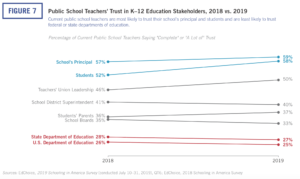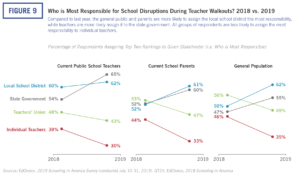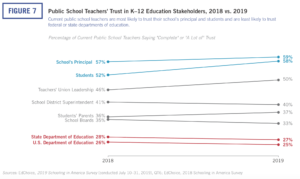Last month, EdChoice released the results of the latest edition of its Schooling in America survey. Though the study’s findings were multifold, the connecting thread and the single most salient theme seems to be that concrete information about specific aspects of school choice and education reform more often than not serves to improve the respondent’s attitude toward said policy or position.
The survey consisted of close to two thousand online and phone interviews; roughly a quarter of the subjects were current K-12 parents, an additional 395 had previously had children in school. The survey also obtained responses from over 600 current public school teachers. Additionally, in the 2019 installment, EdChoice made a concerted effort to solicit responses from Millennial and Generation Z subjects by collecting interviews with subjects born after 1981.
Some of the study’s most interesting findings came from its interviews with K-12 educators. For instance, one of the questions asked teachers about their level of trust in various educational stakeholders. School principals and students (i.e. the groups that the teachers have the most contact with) came in atop the rankings, with roughly 60% of surveyed teachers saying that they have “complete” or “a lot of” trust in both. “Parents” as a category came in at 37%, while state and federal departments of education ranked at the bottom with only about 25% each. It bears restating that from top to bottom the groups were rated in roughly the same order as their distance from the classroom teacher.

One of the more attention-grabbing pieces of data found in the study pertains to the favorability of a teacher walk out or strike aimed at attaining higher pay. In one form of the question, 67% of teachers supported a labor action while the number stood at 63% for the general public and 62% for current parents. In the second form, respondents were provided with the average national teachers’ salary (roughly $60,000) and asked if they would support a walkout or strike aiming to bring about a 10% increase in pay. In the latter variation, parents’ support was 4 percentage points lower, the general public’s was 8 percentage points lower, while teacher support rose to 75%.
In another point of education labor related data, there was a marked change in the area of assigning responsibility for labor actions in the wake of last year’s teacher strikes and walkouts. A year ago, among both school parents and the general public, teachers’ union leadership was regarded as most responsible for strikes, then came state and local authorities, while individual teachers ranked last. In 2019, however, while teachers still ranked last in terms of alleged responsibility (in fact, among both parents and the general public the figure dropped roughly ten percentage points), state governments and local school districts surpassed teachers’ unions, perhaps signaling a union messaging success.

When it comes to school choice topics, the study asked its respondents about their level of support for different private choice programs and for public charter schools. Across the board, there was a marked increase in support for the various options in question when information explaining what said program or proposal entails was provided. The biggest variation between responses to the base form of the question and that providing a more detailed explanation came in the case of education savings accounts (a jump from 46% to 77% among the general population). There was a 23 percentage point increase when it came to vouchers and a 13 point increase when the topic was charter schools. A key takeaway here is that the benefits of choice in education speak for themselves but much of the public may still be unaware of these and as such may form their opinions based either on preconceptions or political talking points.
In addition to the above, the EdChoice study, especially in its last third, contains a wealth of information on educational experiences and attitudes broken down by generational categories.









